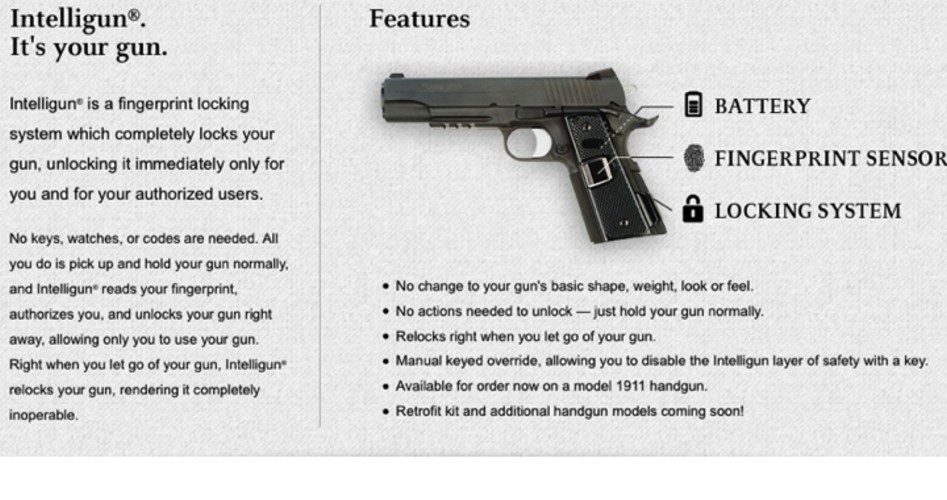
Smart-gun inventor Bill Gentry of Kodiak Industries threatened in a closed 2013 meeting with Attorney General Eric Holder to “burn it down” if his new technology is mandated by gun control laws. Gentry’s “Intelligun” includes a patented trigger-lock device that can be unlocked only by a fingerprint, much like how iPhones are often locked or unlocked with fingerprints.
Gentry is a strong defender of the Second Amendment, but his product caught the eye of the gun-grabbers in Washington. “This interested Eric Holder,” Gentry told National Review of the April 2013 meeting with Holder. “He wondered how we might be able to control who was or wasn’t authorized. I stopped him right there. I looked right across a table at Eric Holder — yeah, the attorney general of the United States — and told him, ‘If you try to mandate my smart-gun technology, I’ll burn it down.’ The Intelligun is designed to save lives, not restrict freedom.”
“Our industry is committed to providing extensive education and training for responsible gun ownership,” Gentry said in a press release on the company website. “While we intend to continue researching, producing, and distributing the most innovative products for our customers, we also remain committed to the Second Amendment rights of all Americans. We oppose the idea of mandating such technology through political means. Not only is such legislation misguided, it’s also realistically impossible to retro-fit all firearms currently in circulation today.”
The Salt Lake City, Utah, company’s $399 accessory is currently available only for model 1911 guns, which typically involve the .45 caliber model made famous by Colt. The lithium-ion battery that powers the electronic device is expected to last about a year, or less if used regularly. It’s unclear if the gun would work if there were a power surge such as a lightning strike or EMP detonation.
Kodiak initially sold his accessory only to law enforcement, but has now opened sales to the general public. Interestingly, the whole “smart-gun” idea started with a 1994 grant under the Clinton-era Justice Department, according to the NRA:
FBI statistics show that during the decade 1987-1996, dozens of law enforcement officers in the United States were killed by criminals who wrested their firearms away and then shot them or other officers. To decrease the chances of officers being feloniously shot with their own guns in the future, the National Institute of Justice (NIJ) funded a “Smart-Gun Technology Project” in 1994.
Kodiak will soon have several competitors in the market, including Armatix, which produces a safe gun that is unlocked by a watch when the watch is in close proximity to the gun.
Leftists have criticized Second Amendment organizations for dragging their feet on “smart-gun” technology, or even outright opposing it. In fact, the NRA has a neutral position on the technology. In a 2013 press release, the gun organization stated,
NRA does not oppose new technological developments in firearms; however, we are opposed to government mandates that require the use of expensive, unreliable features, such as grips that would read your fingerprints before the gun will fire. And NRA recognizes that the “smart guns” issue clearly has the potential to mesh with the anti-gunner’s agenda, opening the door to a ban on all guns that do not possess the government-required technology.
That mandate has already been enacted by New Jersey, in a 2002 law banning the sale of regular handguns three years after any smart-gun technology is available for sale in any state. Firearms researcher Dave Kopel noted, “Banning the sale of every handgun except one or a few models isn’t quite as complete a form of prohibition as banning the sale of all handguns. But it’s pretty close.”
It certainly makes the purchase of firearms for self-defense cost-prohibitive for the poor, when one adds a $399 surcharge on top of a gun that’s often more than $500 to begin with.
And the “smart gun” technology remains untested for reliability in the field. Kopel noted that the New Jersey law stipulated:
The provisions of this section shall not apply to handguns to be sold, transferred, assigned and delivered for official use to: (1) State and local law enforcement officers of this State; (2) federal law enforcement officers and any other federal officers and employees required to carry firearms in the performance of their official duties; and (3) members of the Armed Forces of the United States or of the National Guard.
Of course, if the state expected the new “safe guns” to be reliable, why didn’t they mark them as mandatory for their own police officers?



